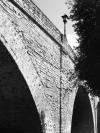Resumen
A lo largo de la segunda mitad del siglo xix, en el sur occidente de Colombia, se construyeron al menos 30 puentes de arco deladrillo: una tipología estructural compleja que sin duda requería de un conjunto de conocimientos técnicos específicos parasu realización. ¿De qué manera se gestó entonces y allí una tradición constructiva capaz de alcanzar una madurez que permitióobras de envergadura significativa? A través de un proceso investigativo que combinó el trabajo de campo y la búsquedadocumental de archivo, se logró precisar su origen en la figura de un sacerdote italiano que llegó a Popayán en 1859 y cuyasenseñanzas prácticas a obreros y maestros de obras locales sirvieron de base a un proceso de apropiación tecnológica singular.Mediante la reseña historiográfica de la obra de Serafín Barbetti y el análisis de su obra, situándola dentro de la culturatécnica de su época, se logra precisar su papel como agente transmisor de conocimientos y las adaptaciones que la hicieronpróspera. Este trabajo se enmarca en una línea de investigación mucho más amplia relacionada con la historia de la técnicaconstructiva y sus mecanismos de difusión y asimilación.La revista Apuntes se encuentra registrada bajo la licencia Creative Commons Reconocimiento 4.0 Internacional. Por lo tanto, esta obra se puede reproducir, distribuir y comunicar públicamente en formato digital, siempre que se reconozca el nombre de los autores y a la Pontificia Universidad Javeriana. Se permite citar, adaptar, transformar, autoarchivar, republicar y crear a partir del material, para cualquier finalidad (incluso comercial), siempre que se reconozca adecuadamente la autoría, se proporcione un enlace a la obra original y se indique si se han realizado cambios. La Pontificia Universidad Javeriana no retiene los derechos sobre las obras publicadas y los contenidos son responsabilidad exclusiva de los autores, quienes conservan sus derechos morales, intelectuales, de privacidad y publicidad.
El aval sobre la intervención de la obra (revisión, corrección de estilo, traducción, diagramación) y su posterior divulgación se otorga mediante una licencia de uso y no a través de una cesión de derechos, lo que representa que la revista y la Pontificia Universidad Javeriana se eximen de cualquier responsabilidad que se pueda derivar de una mala práctica ética por parte de los autores. En consecuencia de la protección brindada por la licencia de uso, la revista no se encuentra en la obligación de publicar retractaciones o modificar la información ya publicada, a no ser que la errata surja del proceso de gestión editorial. La publicación de contenidos en esta revista no representa regalías para los contribuyentes.


